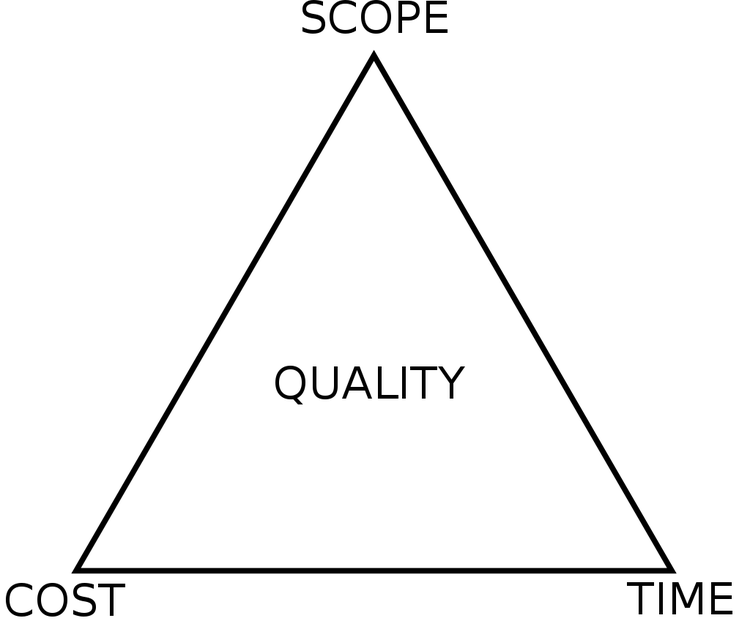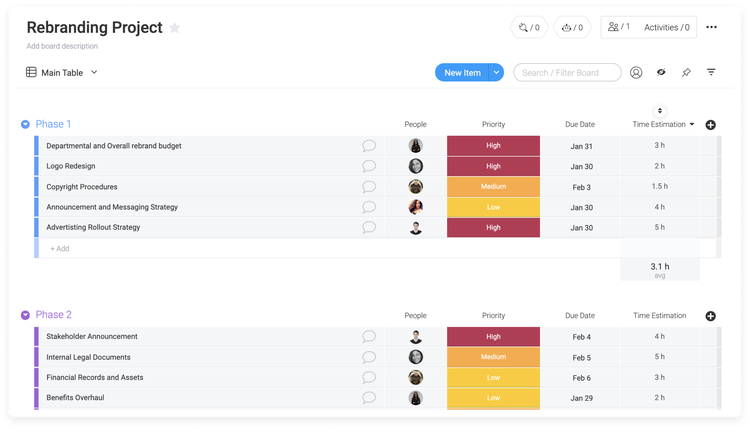There are many aspects to successfully managing a project. Not only do you need to create and follow an effective project timeline and a detailed budget; you also need to be prepared for all the obstacles that are bound to pop up along the way.
The good news is that understanding, anticipating, and tackling potential limitations in advance will ultimately help keep your project right on track. Furthermore, maintaining a responsive and acute focus allows you to address new problems before they negatively impact the success of your project.
Let’s take a closer look at the most common project constraints, when they’re likely to appear, and how to successfully handle them.
Overview: What are project constraints?
It’s important to think about the criteria and the constraints when it comes to any project. The criteria are the things needed to bring the project to fruition. In comparison, the constraints refer to anything that can slow down, interfere, pause, or even cancel your project.
Most project constraints are interconnected, creating a chain reaction to influence the project’s trajectory.
For example, let’s say your company wants to create a new website with 15 pages. This is the main goal, also referred to as the project scope. There will be a list of criteria that goes along with this objective, such as creating a domain name, finding a hosting platform, and designing the pages.
As the project’s scope is adjusted, the other primary variables are affected, such as the time and cost involved in attaining this specified goal. However, if cost constraint is the main priority, the other factors will need to change. For example, having limited funds might mean you’re only able to afford a website with five pages instead of the initially imagined 15 pages.
6 project constraints that can affect your project
If you’ve been managing projects for a while, you’ve most likely heard of the triple constraint, also called the iron triangle. This refers to the three most common constraints seen in project management -- scope, time, and cost.

The triple constraint is a common concept in project management. Image source: Author
But there’s really a full range of problems, limitations, and obstacles beyond the triple constraint. That’s why it’s important to think broadly when addressing potential problem areas. You want to be as prepared as possible and ready to tackle each issue as soon as it arises.
In addition to the triple constraint, three more risk factors bring us to a total of six common project constraints to consider:
- Scope
- Time
- Cost
- Quality
- Sustainability
- Customer satisfaction
The best way to stay on top of your project constraints is to use project management software. That way, you can easily collaborate with team members, stick to a budget, propose your timeline, and address common constraints during the full life of the project.
1. Scope
This is where you define the project’s specific goal. Keep in mind that the final vision is influenced by the time and funds available. For example, you might dream of publishing 10 books, but you only have time to do one. It’s important to keep your end goal realistic and attainable -- otherwise, you risk losing momentum or resources before you reach completion.

Use project management software to keep your team members included in every step along the way. Image source: Author
It’s important to involve all team members from the beginning so they can help chime in when it comes to breaking down the project into manageable chunks. With everyone working together, you can help address every problem that is bound to inhibit or negatively impact the project.
2. Time
This is the approximate time needed to bring the project to completion. Make sure to include specific deadlines for each phase, as well as a final date for completion. Then highlight which areas are most likely to create problems.
For example, the company’s new website is estimated to take two months to complete. However, the holiday shopping page needs to be up in three weeks in order to maximize sales. You’ll need to adjust the timeline to exclusively focus on this task before tackling the other jobs.
3. Cost
Every project will be guided by the funds available. If resources are limited, make sure to adjust your project scope and timeline accordingly.
Keep in mind that the final cost should include money for materials, labor, quality control, contractors, and more. Try to include extra funds for unexpected costs that may arise along the way.
Above all, make sure to stick to your business’s master budget. If funds are allocated to several projects this year, it’s important to adjust the current budget to avoid draining your financial resources.
4. Quality
This goes beyond the project’s scope. It determines whether the final result is suitable enough for the company’s needs.
For example, the goal might be to create a brochure showcasing your company’s services. But if the brochure ends up poorly designed, is hard to read, or the colors are dreadfully boring, the project has failed.
We’ll discuss how to maintain quality control in more detail later.
5. Sustainability
It’s important to think about the long-term sustainability of your project.
For example, if you’re creating a new company website, here are some questions you should be asking:
- Will future employees be able to easily navigate the interface?
- Can you update the theme to fit your company’s changing needs?
- Does it convey your company’s overall message?
- Will it fit current trends several years from now?
Another example is in creating a new product. In theory, using the cheapest materials means higher revenue for your company. However, if the product’s not built to last, the reputation of your company will falter. Therefore, it’s essential to think about the sustainability of each project.
6. Customer satisfaction
Before embarking on a new project, it’s important to brainstorm about what you think will make customers happy.
Let’s say you’re designing a new website or brochure. You want to think about the following questions:
- Is it easy to understand?
- Is it cost-effective?
- Does it draw attention to the products and services?
By thinking about the customer before starting the project, you’ll be able to drive the project in the right direction. In some cases, there is no “customer” but simply stakeholders or people higher up in the company. Either way, thinking about what they want to get out of the project will help keep it on track.
How to avoid project constraints
Now that you have a general grasp of some of the common constraints that arise during a project, it’s time to figure out how to avoid them.
1. Plan and strategize
The more you can brainstorm, plan, and spell out the details in advance, the better equipped your team will be to avoid common constraints.
Here are some areas to focus on:
- What needs to happen: Define the ultimate goal, breaking it down into bite-sized tasks. Avoid adding in extra details after the scope has been approved unless you’re prepared to alter the timeline and extend the budget.
- When each phase needs to be completed: Create a stellar timeline and keep fine-tuning it along the way. Definitely make sure to include buffer time for unexpected situations, such as if a team member gets sick.
- Which resources are needed: Think about everything that’s needed to finish the project, such as hiring contract workers, consulting with specialists, or ordering supplies from overseas distributors.
- Have a Plan B: The best-laid plans can go astray. The initial prototype might need to be redesigned, or a crucial part could get lost in the mail. We’ve all been there. It’s important to draw up a Plan B, and even a Plan C, for all the “what ifs” that could occur.
The more you can understand and anticipate the common constraints and how they’ll affect your project, the more you can plan around them.
Make sure to include all team members in this brainstorming phase -- they might think of something you haven’t encountered before.
Above all else, embrace the constraints. The more you ignore them, the more likely they’ll creep up on you. You want to go forth with all the armor needed to take down those annoying obstacles!
2. Keep up with quality control
As we discussed above, it’s not enough to simply stick to the project’s schedule, budget, and scope. If the goal is to create a quality product, you need to devote some serious time to managing the production.
This is why it’s important to understand the nuances of project quality management and to create a system for checking off each stage of the project.
For example, if Ralph needs to give the final OK on the completed project, make sure he’s involved at each key stage. Otherwise you risk getting to the end only to realize Ralph hates it all. Nothing is worse than having to start over from the beginning.
3. Balance the workload
Often projects can stall out because too many tasks fall on one team member’s plate. You can easily view every team member’s to-do tasks when using project tracking software.

Easily assign tasks, set priorities, and keep track of time estimates with Monday.com. Image source: Author
For example, Monday.com offers time tracking charts as well as a shared calendar, making it easy to keep on top of your team’s workload. Make sure to include regular check-ins with your team members. If one person falls behind, it can create a backlog in the system.
4. Remain flexible
It’s crucial to stick to your timeline as if it’s the map to a hidden chest of golden treasures. Deviate too much and you risk losing the bounty!
However, it’s OK to change things up for the sake of maintaining a high-quality project or to avoid burnout.
For example, perhaps an early phase is taking longer than anticipated. Or a team member is feeling overwhelmed and they’re the only one who can adequately complete that phase.
If necessary, you might need to add an extra week or two to the timeline. If you created a timeline with some wiggle room, this shouldn’t lead to a complete apocalyptic shutdown.
In the end, cutting corners often leads to more work down the road, so it’s better to adjust the schedule in order to do things right.
Tackle project constraints with preparation and responsiveness
No one can predict or prepare for every possible problem that’s bound to arise within a project. But with enough planning, brainstorming, and acute attention, you can address plenty of common limitations in advance.
Staying focused throughout the project can help you see new problems as they begin to appear. This level of responsiveness is crucial. Avoid coasting along since it’s often when we think everything is going smoothly that a new glitch will appear.
Remember, too, that constraints can sometimes be a good thing. Maybe you were planning a massive conference for your company, but limited funds mean you need to significantly scale it back. In turn, the conference ends up being smaller and more intimate, allowing participants to engage more directly with each other. Not every problem leads to complete disaster.
Our Small Business Expert
We're firm believers in the Golden Rule, which is why editorial opinions are ours alone and have not been previously reviewed, approved, or endorsed by included advertisers. The Ascent, a Motley Fool service, does not cover all offers on the market. The Ascent has a dedicated team of editors and analysts focused on personal finance, and they follow the same set of publishing standards and editorial integrity while maintaining professional separation from the analysts and editors on other Motley Fool brands.